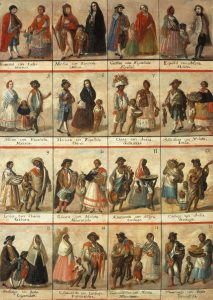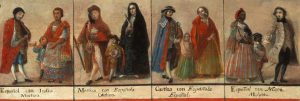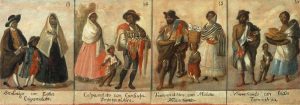I will be honest – Before LAST100, I had never heard of Casta Paintings before. However, after watching the lecture video, reading “Casta Paintings” by Susan Deans-Smith, and taking a closer look at these paintings, I have learned a fair bit.
Casta paintings depict the different mixes in Latin America, starting with 3 different ‘purebreds’ – Spaniards “Españoles”, Indigenous peoples “Indios/as”/“Mestizo” and Blacks “Moras”

In the Casta Paintings shown above, the families of three are painted against a plain background, and each picture is captioned by the mix that they are.
Initially, before I truly analyzed the individual paintings, and simply looked at the captions, I thought it was interesting and almost humorous, since they have truly come up with a name for so many of the mixes. My first impression, without looking at their clothing or what their probable occupations implicate, I got the the impression that they were encouraging racial harmony as the different mixes of races are getting together. However, I was not really close with this first impression.
Upon closer inspection, I could see the distinct differences in the way that the families in each panel are portrayed. Additionally, the paintings are numbered, possibly implying that there is a certain order or hierarchy involved between the different ethnic mixes. When looking at the clothing of the the families in the first row, you can see that they are all well-dressed.

The men, women and children are all dressed with gowns, capes, white socks, and/or black shoes, and while their occupations are not extremely clear, it is evident that they have prestigious professions. There is a stark contrast to this in the final row.

In the 14th to 16th panels, as the people become more interbred, their clothing is not as fancy, they are no longer wearing shoes (in the 15th and 16th frame) and their occupations become less ‘professional. The families are shown to be something along merchants of jewelry, clothes, shoes and bread. Additionally, one of their subtitles or ‘classifications’ is “Note entiendo”, which in Spanish means “I don’t understand you”. It is only after analysing these images and their portrayal of mix-bloods that one could agree with Dr. Andrés Arce y Miranda’s negative opinion toward the paintings – as they insinuate the “lower class” of mixed-bloods in Latin America.
Something that I wonder with these illustrations of the mixes, is whether or not they are representations of how the demographics truly were at the time (with regards to their general occupations and the way they dressed), and therefore prompting the paintings. Alternatively, they could’ve been painted first, thus creating a form of social stigma against mixed-blood peoples. As the lecture video pointed out, it could’ve been done due to the anxieties felt by the dilution of their race through the generations, and their desperation to maintain a social hierarchy by defining a clear divide between the mixes with more Spaniard blood and their subsequent dilutions. I am interested in this because as a Mexican, I have heard my great-grandfather talk about the discrimination against ‘mestizo’ Mexicans, and how fair-skinned Mexicans were treated better because of their apparent Spanish blood.
Nevertheless, other than showing me the class-divide of the time, the Casta Paintings have made me see Latin America in a different light and in a way that I have never truly looked at it before. In the 17th and 18th centuries, Latin America was seen these different mixes were classified and given a name, making it like a hub of racial diversity due to these different mixes, dilutions and concentrations of ethnicities. However, over time, these distinctions have become less clear, seemingly less ‘diverse’ because all of the different mixes have combined to become one due to racial harmony and acceptance… When you walk down the streets in Latin America, you’re not seeing people as “Mora” or “Calpamulato” or even “Note Entiendo”, instead you see each other reunited under “Latino/a”.
I know this post is quite long, but I guess there is a lot to reflect on. This now brings me to a discussion question for you – How do you think life actually was for these various mixes in 17th and 18th centuries? Do you think that these Casta Paintings were accurate representations of the people at the time, or simply depictions of how the Spaniards wanted them to be?

Hi Michelle,
I think that the casta paintings were a representation of the already stereotypes associated with the different mixes. I think this because the paintings were ade in the 17th and 18th centuries, a long time after the colonization of the Americas started. And as you said about your grandpa, I beleive these social stigmas have been upheld from then until now, though the way in which it’s enforced as changed over time.
I think that life was probably quite hard for those of mixed races. From the idea we get from the paintings and the names of the different classifications, we get the idea that the more intermixing of races there was, the less highly regarded the person was. As to how they were treated, I think they were probably like outcasts. If we take a mulatto for example, they probably were seen as better as negros and therefore alienated from that group, but then also not good enough to be treated as an espanol. I think those of mixed blood would probably only really identify with others of similar racial backgrounds.
The Spaniards certainly felt differently about people of the mixed race. Its incredibly to me that once the colonial period ended everyone was considered equal. Latin America took a massive blow economically largely due to years of Spanish and European dominance, however despite this blow, a large majority of people of every race have embraced the ”latino” categorization throughout the americas.